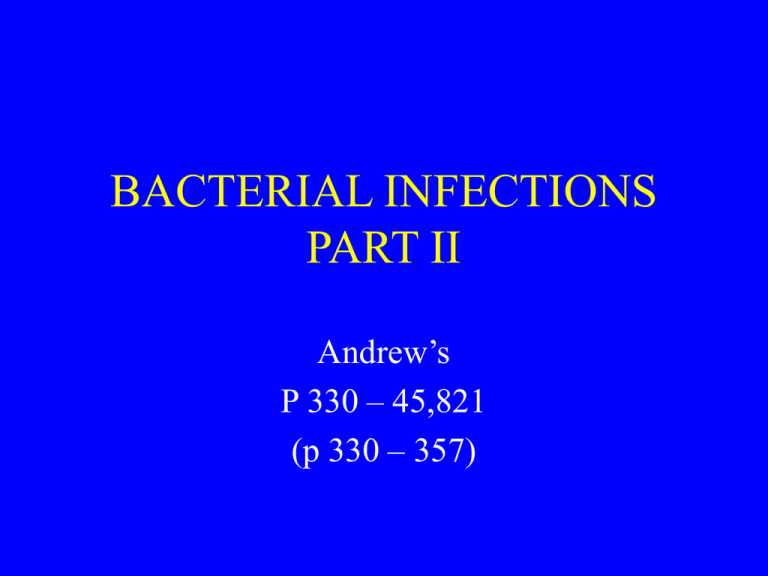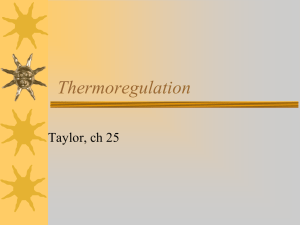
BACTERIAL INFECTIONS
PART II
Andrew’s
P 330 – 45,821
(p 330 – 357)
Gas gangrene
(clostridial myonecrosis)
• Most severe form of infectious gangrene
• Develops in deep lacerated wounds of
muscle tissue
• Incubation only a few hours
• Sudden onset characterized by a chill, rise
in temp, marked prostration and severe local
pain
• Gas bubbles cause crepitation
Gas gangrene
(clostridial myonecrosis)
• Mousy odor is characteristic
• Caused by a variety of species of the genus
Clostridium
• Most frequently C. perfringens, C.
oedematiens, C. septicum, and C.
haemolyticum
• A subacute variety occurs –
peptostreptococcus
• Clinically similar but with a delayed onset
treatment
• Treatment of all clostridial infections is
wide surgical debridement and intensive
antibiotic therapy
• Hyperbaric oxygen therapy may be of value
if immediately available
Chronic undermining burrowing
ulcers
• Meleney’s gangrene
• Described as a postoperative progressive
bacterial synergetic gangrene
• Usually follows drainage of peritoneal
abscess, lung abscess, or chronic empyema
• Three skin zones – outer bright red; middle,
dusky purple; and inner, gangrenous with a
central area of granulation tissue
• Pain is excruciating
Chronic undermining burrowing
ulcers
• The essential organism is a microaerophilic,
nonhemolytic streptococcus in the
spreading periphery of the lesion ,
associated with S. aureus or
Enterobacteraceae in the zone of gangrene
• Wide excision and grafting are primary
therapy
• Antimicrobial agents, pcn, and an
aminoglycoside should be given as
adjunctive therapy
Fournier’s gangrene of the penis
or scrotum
• A malignant gangrenous infection of the
penis, scrotum, or perineum
• May be due to an infection with group A
strep or a mixed infection with enteric
bacilli and anaerobes
• Usually considered a form of necrotizing
fasciitis
• Aerobic and anaerobic culture
• Appropriate antibiotics, sx debridement
Infections caused by gramnegative organisms
PSEUDOMONAS
INFECTIONS
ecthyma ganrenosum
• In the gravely ill patient opalescent, tense
vesicles or pustules surrounded by narrow
pink to violaceous halos
• Quickly become hemorrhagic and rupture to
become round ulcers with necrotic black
centers
• Usually seen on the buttocks and
extremities
ecthyma ganrenosum
• Occurs in debilitated persons who may be
suffering from leukemia, in the severely
burned patient, in pancytopenia or
neutropenia, functional neutrophilic defect,
terminal carcinoma, and other severe
chronic disease
• Healthy infants in the diaper area, on abx
• Classic vesicle should suggest the diagnosis
ecthyma ganrenosum
• Contents will show gram-negative bacilli
• Culture grows Pseudomonas aeruginosa
• Treatment with immediate institution of IV
anti-Pseudomonals
• And aminoglycoside in combination with
antipseudomonal penicillin
Green nail syndrome
• Characterized by onycholysis of the distal
portion of the nail and a striking greenish
discoloration
• Frequently associated with paronychia in
persons whose hands are often in water
• 1% acetic acid solution soaks
• Neosporin solution
Gram-negative toe web infection
• Often begins with dermatophytosis
• Dermatophytosis complex – where many
types of gram-negative organisms may be
recovered, and as the inflammation and
maceration progress, it is less often possible
to culture dermatophytes
• Prolonged emersion may lead to overgrowth
treatment
• Topical antifungals
• With progression of disease – topical
antibiotics and acetic acid compresses
• Systemic antibiotics in full blown infection
Blastomycosis-like pyoderma
• Large verrucous plaques with elevated
borders and multiple pustules may occur as
a chronic vegetating infection
• Most patients have underlying systemic or
local host compromise
• P. aeruginosa, S. aureus, Proteus, E. coli or
streptococci may be isolated
• Cipro 500 mg bid
Pseudomonas aeruginosafolliculitis
• Hot tub folliculitis
• Characterized by pruritic, follicular,
maculopapular, vesicular, or pustular lesions
• Occurs 1-4 days after swimming in a hot
tub, whirlpool, or public swimming pool
• Most lesion occur on the side of the trunk,
axillae, buttocks, and proximal extremities
• Associated complaints may include earache,
sore throat, headache, fever, malaise
• Typically involutes within 7-14 days
without therapy, prolonged episodes have
been reported
• Third generation oral cephalosporin or a
fluoroquinalone
• Prevention measures include water
filtration, chlorination, maintenance of
water, and frequent changing
External otitis
• Swelling, maceration and pain may be
present
• In up to 70% of cases P. aeruginosa may be
cultured
• Especially common in swimmers
• Local applications of antipseudomonal
Cortisporin Otic Solution
• Post op external otitis
External otitis
• Malignant external otitis
• Occurs in elderly patient with diabetes
• Swelling, erythema and pain are more
pronounced, with purulence and a foul odor
• Facial nerve palsy develops in 30% of the
cases
• Cartilage necrosis may occur
• May be life threatening
• Appropriate systemic antibiotics
Gram-negative folliculitis
• Usually due to Enterobacteraceae,
Klebsiella, Escherichia, Proteus, or Serratia
• Occasional cases caused by Pseudomonas
malacoplakia
• Rare granuloma, originally reported only in
the genitourinary tract of
immunosuppressed renal transplant
recipients
• May also occur in the skin an the
subcutaneous tissues of other patients with
deficient immune responsiveness (HIV)
• Patients are unable to resist infections with
S. aureus, P. aeruginosa and E. coli
malacoplakia
• Granulomas may arise as yellowish red
papules in the natal cleft, as draining
sinuses in the vicinity of the urethra, as
perianal ulcers, , as a painful draining
abscess on the thigh, or as a lesion on the
vulva
• Treatment depends on the isolated organism
• Fluoroquinalones are usually useful
Haemophilus infuenzae cellulitis
• Haemophilus infuenzae type B a distinctive
bluish or purplish red cellulitis of the face
accompanied by fever in children below age
2
• Bacteremia may result – meningitis, orbital
cellulitis, osteomyelitis, or pyarthrosis
• Antibiotic therapy
• Vaccine available, given at 2, 4, and 6
months
chancroid
• An infectious, contagious, ulcerative,
sexually transmitted disease
• Haemophilus ducreyi gm- bacillus
• One or more deep or superficial tender
ulcers on the genitalia and painful adenitis
in 50%
• Men > women
chancroid
• Begins as an inflammatory macule or
pustule 1-5 days after intercourse
• Generally appears on the distal penis or
perianal area in men
• On the vulva, cervix, or perianal area in
women
• Extragenital infections have been reported
• Autoinnoculation forms “kissing-lesions”
chancroid
• Pustules rupture and ulcers form
• These bleed easily and are very tender
• the lymphadenitis of chancroid is mostly
unilateral, tender and may rupture
spontaneoulsy
• Culture for definitive diagnosis and
sensitivity testing
chancroid
• The selective medium contains vancomycin
• Smears are only diagnostic in 50 %
• A combined PCR technique allows for the
diagnosis of syphilis, herpes simplex, and
chancroid form a single swab
• The diagnosis of chancroid does not rule out
syphilis
• Repeat serologic testing and HIV is rec.
• Chancroidal genital ulcer disease facilitates the
transmission of HIV infection
treatment
• Treatment of choice is azithromycin 1 gm
orally as a single dose
• Partners with contact less than ten days out
should also be treated
Granuloma inguinale
(granuloma venereum, Donovanosis)
• A mildly contagious, chronic, granulomatous,
locally destructive disease
• Characterized by progressive, indolent,
serpiginous ulcerations of the groin, pubes,
genitalia and anus
• Begins as single or multiple subcutaneous,
nodules, which erode through the skin to produce,
clean, sharply defined lesions, which are usually
painless
Granuloma inguinale
(granuloma venereum, Donovanosis)
• More than 80% of cases demonstrate
hypertrophic, vegetative granulation tissue,
which is soft, has a beefy-red appearance,
and bleeds readily
• Genitalia are involved in 90% of cases,
inguinal region 10%
• Most commonly occur on the prepuce or
glans in men, and on the labia in women
Granuloma inguinale
(granuloma venereum, Donovanosis)
• Incubation period is unknown, 8-80 days, 23 weeks most common
• Persisting sinuses and hypertrophic scars,
devoid of pigment are characteristic of the
disease
• Regional lymph nodes are usually not
enlarged
• Lesions are not painful and produce only
mild subjective symptoms
Granuloma inguinale
(granuloma venereum, Donovanosis)
• Pseudoelephantiasis may occur with
blockage of lymph channels
• Dissemination from the inguinal region may
be by hematogenous or lymphatic routes
• Calymmatobacterium granulomatis
• The exact mode or transmission of infection
is undetermined
Granuloma inguinale
(granuloma venereum, Donovanosis)
• The role of sexual transmission is
controversial
• Giemsa or silver stains for Donovan bodies
• May coexist with syphilis
• Test for HIV
• Trimethoprim-sulfamethoxazole
• Doxycycline
• Therapy continues until all lesions have
healed
Gonococcal dermatitis
• Primary gonococcal dermatitis is a rare infection
that occurs mostly as erosions that may be 2 - 20
mm
• Has been reported on the median raphe without
urethritis, as extragenital gonococcal ecthyma,
simulating herpetic whitlow, and as scalp
abscesses in infants secondary to direct fetal
monitoring
• cipro
gonococcemia
• Characterized by a hemorrhagic vesiculopustular
eruption, bouts of fever, and arthralgia or acute
arthritis of one or several joints
• Lesions begin as tiny erythematous papules
• Evolve into vesiculopustules on a deeply
erythematous base or a purpuric macule
• The purpuric lesions occur acrally, mostly on the
palms and soles and over joints
gonococcemia
• Fever, chills, malaise, migratory polyarthralgia,
myalgia, and tenosynovitis may accompany
lesions
• Lesions are usually tender and sparse, and occur
principally over the extremities
• Involution in about 4 days
• Many patients seen are women with asymptomatic
anogenital infections in whom dissemination
occurs during pregnancy or menstruation
gonococcemia
• In severe or recurrent cases compliment
deficiency should be investigated, esp. C5,
C6, C7 or C8
• Neisseria gonorrhoeae
• Organisms may be seen in early skin
lesions, blood, GU tract, and joints
• TOC ceftriaxone IV I gm daily for 24 – 48
hours after improvement begins, then
switching to PO for another week of TX
meningococcemia
• Presents with fever, chills, hypotension, and
meningitis
• About ½ - 2/3 of patients develop a
petechial eruption , most frequently on the
trunk and lower extremities
• This may progress to ecchymosis, bullous
hemorrhagic lesions, and ischemic necrosis
• Oral and conjunctival mucous membranes
may also be affected
meningococcemia
• Primarily affects young children
• Males more frequently than females
• Inherited or acquired deficiencies of the
terminal components of compliment or
properdin are predisposed to infection
• Chronic meningococcemia is a rare variant,
seen typically in young adults
• Neisseria meningitides, gm – diplococcus
• Human nasopharynx is the only known
reservoir
• Carriage rates = 5 – 10 %
• TX, PCN G
• Chloramphenicol if pcn allergy
• Household members, and day-care and
close school contacts should receive
prophylactic therapy
• Vaccine available for high risk groups
Vibrio vulnificus infection
• Vibrio vulnificus, gm – rod
• Infection produces a rapidly expanding
cellulitis or septicemia in those exposed
• May be acquired via the GI tract, after
eating raw oysters or other seafood
• Localized skin infection may occur
following exposure of an open wound to
sea water
Tabasco kills Vibrio, right?
Vibrio vulnificus infection
• Skin lesions begin within 24-48 hrs
following exposure
• Localized tenderness, erythema, edema, and
indurated plaques are seen in 90% of pts
• Most common on the lower extremities
• If the skin is invaded primarily, septicemia
may not occur, however with progressive
lesions amputation may be required
• Mortality with septicemia is > 50%
TX
• PCN, cephalosporins, tetracyclines,
cotrimoxazole, chloramphenicol
• Doxycycline with ceftazadime is toc
• Surgical debridement of necrotizing tissue
Chromobacteriosis and
Aeromonas infections
• Chromobacteria are gm – rod
• Common in water and soil in SE US
• Several types of cutaneous lesions, abscesses,
cellulitis, anthrax-like carbuncular lesions
• Chromobacterium violaceum, most common
• Aeromonas hydrophilia, gm –
• Soil and water, similar lesions
salmonellosis
• Gm – rod
• Exist in humans either in a carrier state or as
a cause of active enteric or systemic
infection
• Most cases are caused by ingestion of
contaminated food or water
• Poultry and poultry products are believed to
be involved in half of common-source
epidemics
salmonellosis
• Incubation 1-2 weeks
• Acute onset of fever, chills, HA,
constipation and bronchitis
• Lesions appear as rose-colored macules or
papules (“rose spots”) on the trunk between
umbilicus and nipples
• These occur in crops, lasting 3-4 days
• Untreated the exanthem may last 2-3 weeks
salmonellosis
• Rose spots occur in 50 – 60 % of cases
• Diagnosis is confirmed by culturing the
organism from blood, skin, stool, or bone
marrow
• TOC is a fluoroquinalone or ceftriaxone
shigellosis
• Gm – rods
• Cause bacillary dysentery, or acute diarrheal
illness
• Most cases result from person to person
transmission, food and water
• Small, blanchable, erythematous macules
on the extremities, as well as petechial or
morbilliform eruptions, may occur
• May be sexually transmitted
• fluoroquinolone
Helicobacter cellulitis
• Fever, bacteremia, cellulitis and arthritis
may all be caused by Helicobacter cinaedi
• Generally seen in HIV pts
• Cellulitis may have a distinctive red-brown
or copper color
• ciprofloxacin
rhinoscleroma
• A chronic, inflammatory, granulomatous
disease of the upper respiratory tract
• Characterized by sclerosis, deformity,
remission and eventually debility
• Death may occur
• Infections is limited to the nose, pharynx,
and adjacent structures
• begins insidiously with nasal catarrh,
increased nasal secretion and crusting
rhinoscleroma
• Gradual nodular or diffuse sclerotic
enlargement of the nose
• Ulceration is common
• Lesions have a distinctive stony hardness,
are insensitive, and are of a dusky purple or
ivory color
rhinoscleroma
• Extensive mutilation of the face and marked
disfigurement can occur
• Klebsiella pneumoniae, ssp. Rhinoscleromatis
• Gm – rod
• Occurs in both sexes
• Most common in the third and fourth decade
• Endemic in Austria and southern Russia
• Occ. Found in US
rhinoscleroma
• The bacilli are found within foamy macrophages
known as Mikulicz’s cells
• Best visualized with the Warthin-Starry silver stain
• Disease has such distinctive features that diagnosis
should not be difficult
• Dx on bacteriologic, histopathologic and serologic
tests
• Extremely resistant to therapy
• Fluoroquinalones are the best therapy
pasteurellosis
• Primary cutaneous infection is caused by
Pasteurella hemolytica
• A common pathogen in domestic animals
• A case of a woman with cuts on her hands
who later dressed a deer
Pasteurella multocida infections
•
•
•
•
Pasteurella multocida, gm –
Norma l oral and nasal flora of cats and dogs
May also be an animal pathogen
Most common type of human infection follows cat
and dog bites, and cat scratches
• Erythema, tenderness, and swelling occur within a
few hours
• May have regional lymphadenopathy
• Septicemia is rare
Pasteurella multocida infections
• Rec. all cat bites and scratches, and all
sutured wounds of any animal source
receive pcn or tcn and tetanus prophylaxix
ALL YOU CAN EAT??
I’M THERE!!!!!!!!!!!!!
Dog and human bite pathogens
•
•
•
•
Capnocytophaga canimorsus, DF-2, gm – rod
Normal oral flora of dogs and cats
Assoc with severe septicemia after dog bites
A characteristic finding is a necrotizing eschar at
the site of the bite
• Difficult to identify in the lab, make them aware
• Tx – IV abx
• Amoxicillin clavulanate or pen G for human bites
glanders
•
•
•
•
Rare, usually fatal
Pseudomonas mallei
Encountered in horse handlers
The distinctive skin lesion is an
inflammatory papule or vesicle that arise at
the site of inoculation
• This rapidly becomes nodular, pustular, and
ulcerative
glanders
• Within days or weeks other nodules, “farcy buds”,
develop along the lymphatics in the adjacent skin
or subcutaneous tissues
• Respiratory mucous membranes are esp.
susceptible to disease
• Dx made by finding of the organism in nasal
discharge or skin ulcers
• Tx- surgical excision of inoculated lesions
• And streptomycin plus a tetracycline
melioidosis
• Whitmore’s disease
• Burkholderia pseudomallei
• The disease has an acute pulmonary and
septicemic form with multiple miliary abscesses in
the viscera and ends in early death
• Clinical characteristics are similar to glanders,
disseminated fungal infections, and tb
• Endemic in Southeast Asia, suspect in military
personnel
melioidosis
• Dx made from finding bacillus in skin
lesions or sputum, and serologic tests
• Therapy is guided by sensitivity
• Majority of infections respond to tcn
• Trimethoprim-sulfamethoxazole
• Third generation cephalosporin
Infections caused by Bartonella
• Aerobic, fastidious, gm – bacilli
• Species that infect humans
–
–
–
–
B. henselae
B. quintana
B. bacilliformis
B. clarridgeiae
• Unique to this genus is the ability to cause
vascular proliferation
• Warthin-Starry silver stain
Cat-scratch disease
• Relatively common, 22, 000/yr in US
• 60-90% of cases occur in children and young
adults
• B. henselae, majority of cases
• Cat to cat by fleas
• Cat to human by bite or scratch
• Primary lesion occurs 3-5 days after inoculation
• Occurs in 50-90% of patients
Cat-scratch disease
•
•
•
•
Resembles an insect bite
Heals within a few weeks without scarring
Lymphadenopathy is the hallmark of the disease
Appears within a week or two of the primary
lesion
• Typically regional and unilateral
• Most commonly epitrochlear and axillary – 50%
• Fever, malaise, and anorexia may be present
Cat-scratch disease
• Without treatment adenopathy resolves over a few
weeks or months
• Oculoglandular syndrome of Parinaud
• Acute encephalopathy, osteolytic lesions, hepatic
and splenic abscesses, hypercalcemia, and
pulmonary manifestations
• Dx – clinical features
• Primary skin lesion or lymph node bx
Cat-scratch disease
• Most cases need no treatment
• Fluctuant lymph nodes should be aspirated
• Erythromycin, tetracycline, or doxycycline,
in severe disease
Trench fever
• B. quintana
• Affected more than one million soldiers in
WW I
• Spread from person to person by body louse
• Fever initially lasting a week, recurs every 5
days
• Headache, neck, shin , and back pain
• Ceftriaxone followed by erythromycin
Bacillary angiomatosis
• A clinical condition characterized by
vascular skin lesions resembling pyogenic
granulomas
• Only 2 organisms have been proven to
cause BA
– B. henselae
– B. quintana
• Lesions are identical
• Incubation period is unknown
Bacillary angiomatosis
• BA occurs primarily in the setting of
immunosuppression, esp. AIDS
• Rarely in HIV-negative persons
• Local proliferation of bacteria produces
angiogenic factors leading to the
characteristic skin lesions
• Immunocompetent host resist bacterial
proliferation, resulting in granulomatous
and necrotic lesion
Bacillary angiomatosis
•
•
•
•
Several different cutaneous forms occur
Lesions are tender and bleed easily
Lesions may number from one to thousands
In BA the infection must be considered
multisystem
• Bacteremia detected in 50% of AIDS pts
• Dissemination to lymphnode, liver and
spleen, and bone
Bacillary angiomatosis
• The source of infection and pattern of visceral
disease can predict the infecting agent
• Radiologic or imaging studies may confirm
visceral disease
• Bone lesions are typically lytic
• In the liver and spleen “ peliosis” occurs
• BA is distinguished from pg by the presence of
neutrophils throughout the lesion
Bacillary angiomatosis
• Natural history of BA is extremely variable
• In most patients, the lesions either remain stable ,
or most commonly, the size and number of lesions
gradually increases
• Untreated BA can be fatal
• Patients die of visceral disease or respiratory
compromise from obstructing lesions
• Dx- id infecting organism in affected tissue
Bacillary angiomatosis
• Tissue and blood cultures may be confirmatory,
rather than primary diagnostic
• BA is dramatically responsive to tx
• Erythromycin or doxy toc
• Others are affective
• Duration depends on extent of visceral
involvement
• Chronic suppressive therapy may be required
Oroya fever and Verruga Peruana
• These represent two stages of the same
infection
• Oroya fever is the acute febrile stage
• Verruga peruana is the chronic delayed
stage
• Limited to and endemic to Peru and
neighboring countries
• B. bacilliformis, trans. by sandfly
• Humans are the only known reservoir
Oroya fever and Verruga Peruana
• 3 week incubation
• Symptomatology is highly variable, fever,
ha, myalgias may be seen
• Untreated fatality 40 – 88%, with abx 8%
• After the acute infection resolves, a latency
period follows, lasting from weeks to
months
• It is then that the eruptive verruga peruana
occur
Oroya fever and Verruga Peruana
• Angiomatous, pyogenic granuloma-like
lesions, clinically and histologically
virtually identical to those seen in BA
• Large and few, or small and disseminate
• No visceral disease
• Giemsa stain
• toc chloramphenicol
plague
• Infection in humans with Yersinia pestis is
accidental and presents usually as bubonic
plague, gm- bacillus
• Pneumonic and septicemic plague are other
clinical forms
• Mild disease – malaise, fever, pain and
tenderness in regional nodes
• Sever disease – toxicity, prostration, shock,
hemorrhagic pneumonia
plague
• Transmission occurs through contact with
infected rodent fleas or rodents
• Rodents carried home by dogs or cats are a
potential source
• Blood, bubo, or parabubo aspirates,
exudates, and sputum should be examined
• Streptomycin is toc
• nearly all cases are fatal if not treated
promptly
Rat-bite fever
• A febrile, systemic illness usually acquired by
direct contact with rats or small rodents
• Streptobacillus moniliformis
• Spirillum minor
• Bites of lab rats are an increasing source of
infection
• Two distinct forms
• “sodoku” – S. minus
• Semticemia – S. moniliformis, epidemic arthritic
erythema or Haverhill fever
Rat-bite fever
• Clinical manifestations are similar
• Both produce a systemic illness characterized by
fever, rash, and constitutional symptoms
• Clinical differentiation is possible
• Semticemia – S. moniliformis, generalized
morbilliform eruption to include palms and soles,
may become petechial
• “sodoku” – S. minus, bite site is often inflamed
and may become ulcerated
• Eruption begins with erythematous macules on the
abdomen, which enlarge, become purplish red and
forming extensive indurated plaques
Rat-bite fever
• Course without tx is typically 1-2 weeks
• Confirm dx by culturing organism from
blood or joint aspirate
• Prompt cauterization of bites by nitric acid
may prevent the disease
• Pcn, tcn, second or third generation
cephalosporin
Tularemia
(Ohara’s disease, deer fly fever)
•
•
•
•
Francisella tularensis, gm- coccobacillus
Sudden onset of chills, ha, leukocytosis
Incubation of 2 – 7 days
Clinical course is divided into several general
types
• Ulceroglandular type, large majority, begins as a
primary papule or nodule that rapidly ulcerates at
the site of infection
• Contact with tissues or body fluid of infected
mammals
Ulceroglandular type
• Lymphangitis spreads from the primary
lesion
• Ulcers extend in a chain from the ulcer to
the enlarged lymphatic glands
• EM and EN often occur
• The similarity of the primary ulcer to the
chancre of sporotrichosis, or Pasteurella
infections is important in the ddx
Ulceroglandular type
Tularemia
(Ohara’s disease, deer fly fever)
• Typhoidal type – inoculation site is unknown
• Characterized by persistent fever, malaise, gi
symptoms
• Oculoglandular type – primary conjunctivitis
is accompanied by enlargement or regional
lymph nodes
• Pneumonic type, most severe
• Oropharyngeal type
• Glandular type
Oculoglandular type
Tularemia
(Ohara’s disease, deer fly fever)
• Most frequent sources of human infections
are the handling of wild rabbits and the bite
of deer flies or ticks
• Person to person not reported
• Most often occurs in the western and
southern US
• Definitive dx by staining the exudates
smears with specific fluorescent antibody
• Agglutination test is the most reliable
diagnostic procedure
Tularemia
(Ohara’s disease, deer fly fever)
•
•
•
•
Thorough cooking destroys the infection
Toc streptomycin
Gentamycin
tcn
Brucellosis
(Undulant fever)
• Brucellae are gm- rods that produce an
acute febrile illness with headache, or at
times an indolent chronic disease
characterized by weakness, malaise, and
low grade fever
• Acquired primarily by contact with infected
animals or animal products
• Meat-packers and vets at risk
• 5-10 % of pts develop skin lesions
Brucellosis
(Undulant fever)
• Erythematous papules, diffuse erythema,
abscesses, erysipelas-like lesions, and
erythema nodosum-like lesions are some
possible findings
• Dx by culture and rising serum
agglutination titer
• Toc doxy and rifampin for 6 weeks
Rickettsial diseases
Rickettsial diseases
• Rickettsiae are obligate, intracellular, gmbacteria
• Natural reservoirs are blood sucking
arthropods
• Most of the human diseases incurred are
characterized by skin eruptions, fever, ha,
malaise, and prostration
TYPHUS GROUP
epidemic typhus
• Rickettsia prowazekii
• Human contraction from infestation of body
lice harboring organism
• Lice feeds and defacates and feces are
scratched into the skin
• After 2 weeks, prodrome of fever, chills,
aches and pains
• Pink macular eruption on trunk and axillary
folds that spreads rapidly
epidemic typhus
•
•
•
•
6-30 % mortality in epidemics
Agglutinins for OX-19 are seen
Toc doxy, alt. Tcn
Brill-Zinsser disease may occur as a
recrudescence of previous infection, similar
but milder course
Endemic typhus
(murine typhus)
•
•
•
•
R. typhi
Natural infection of rats and mice
Transmitted to humans by the rat flea
Same skin manifestations as epidemic typhus, but
less severe
• OX-19 also +
• Southeastern US and those states bordering the
Gulf of Mexico have been the most common sites
of incidence
• Treatment as for epidemic typhus
RMSF
SPOTTED FEVER GROUP
Rocky Mountain Spotted Fever
• Rickettsia rickettsii
• 1-2 weeks after tick bite, fever, chills, and
weakness
• Eruption begins on ankles, wrists and forehead
• Small red macules which blanch on pressure
• Spread to the trunk in 6-18 hrs, becoming
petechial an hemorrhagic over 2-4 days
• A vasculitis of the skin is the pathologic process
Rocky Mountain Spotted Fever
• 10-20 % of cases without a rash, there is a
risk of delayed diagnosis and a fatal
outcome is the greatest
• Spread by ixodid ticks
• Antibodies to Proteus OX-2 and )x-19
become positive
• Tx – high dose tcn, or chloramphenicol
• Usual course 5-7 days
Tick typhus
• A collective name for the varieties of spotted fever
transmitted by ticks
• Boutonneuse fever, or Mediterranean fever, is an
acute febrile disease is the prototype
• Affects mostly children
• Characterized by sudden onset of chills, high
fever, ha, and lassitude
• Tick bite produces a tache noir, small indurated
papule
• Becomes a necrotic ulcer
Tick typhus
• R. conorii, transmitted by the dog tick
• Similar manifestations are seen with the
other diseases in this group
• Tx- tcn or chloramphenicol
• Even without treatment prognosis is good
and complications are rare
MITE-BORN DISEASES
rickettsialpox
• Acute febrile disease characterized by the
appearance of an initial lesion at the site of
eh mite bite about a week before the onset
of the fever and by the appearance of a rash
resembling varicella 3 or 4 days after the
development of the fever
• The lesions are firm round or oval vesicles
• Regional lymphadenitis
• A secondary eruption appears after the
fever begins and fades within 1 week
rickettsialpox
• Rickettsia akari
• Transmitted by the rodent mite
• All cases have occurred in neighborhoods
infested by mice
• Self limited
• Complete involution in 2 weeks in most
• Toc tcn
Scrub typhus
(tsutsugamushi fever)
• Characterized by fever, chills, intense ha,
skin lesions, and pneumonitis
• Primary lesion is an erythematous papule at
the site of a mite bite
• Becomes indurated, necrotic ulcer with
eschar forms, regional lymphadenopathy
• Erythematous macular eruption begins on
the trunk, extends peripherally, fades in a
few days
Scrub typhus
(tsutsugamushi fever)
•
•
•
•
Rickettsia tsutsugamushi
Vector is the chigger
Antibodies to OX-K proteus antigen
Tx as for other rickettsias
Ehrlichiosis
•
•
•
•
Illness similar to spotted fever
Ehrlichia chaffeensis
Many types of lesions
A generalized mottled or diffuse erythema,
a fine petechial eruption or a macular,
papular or urticarial morphology have all
been seen
• tcn
leptospirosis
• Weil’s disease, pretibial fever, and Fort
Bragg fever
• A systemic disease caused by many strains
of the genus Leptospira
• Starts with abrupt onset of chills, followed
by high fever, intense jaundice, petechiae,
and purpura on the skin and mucous
membranes, and renal disease
• Death in 5-10%
leptospirosis
• Fort Bragg fever, anicteric leptospirosis
• Has an associated acute exanthematous
infectious erythema, generally most marked
on the shins
• High fever, conjunctival suffusion, nausea,
vomiting, ha
• Eruption occurs as erythematous patches or
plaques
• Lesions resolve after 4-7 days
leptospirosis
• May be different clinical manifestations from
identical strains of leptospira
• Humans acquire these accidentally from urine or
infected tissues of infected animals
• Also from contaminated soil or form drinking or
swimming in contaminated water
• Spirochetes in blood by darkfield microscopy
• Tcn and pcn
Borreliosis
• Spirochetes
• Also cause of relapsing fever
• Nonspecific macular or petechial eruption
occurs near the end of the 3-5 day febrile
illness
McGinley-Smith DE, Tsao SS, Dermatosis from ticks. JAAD
2003;49:363-92
Lyme disease
• Borrelia burgdorferi sensu lato, a tickborne
spirochete
• The characteristic cutaneous eruption that is
the early manifestation of systemic illness is
erythema migrans
• Late sequel if chronic infections is
acrodermatitis chronica atrophicans (ACA)
• Clinical features begin with EM and a flulike illness
Lyme disease
• Untreated, chronic arthritis and neurologic and
cardiac complications frequently develop
• Skin eruption occurs in 75% of adults, v 25%
of children
• 20-30% recall a tick bite
• 3-32 days following the tick bite expansion
occurs
• Burning is seen in half of patients, rarely
pruritic or painful
Lyme disease
• 25-50% will develop multiple secondary
annular lesions, typically smaller
• Lesions fade on an average of 28 days
without tx
• 10% develop a chronic arthritis of the knees
• Cardiac involvement most often in young
men, AV block
• Stiff neck, ha, meningitis, Bell’s palsy and
cranial and peripheral neuropathies
Lyme disease
• Nonspecific findings include
–
–
–
–
Elevated ESR
Elevated IgM
Mild anemia
Elevated lft’s (20%)
• Warthin-Starry silver stain
• B. garinii
• B. afzelii, assoc. ACA in Europe
Lyme disease
• In US occurs primarily in Northeast,
Midwest, and West
• Tick transmission, family Ixodidae
• European disease runs a different course
• Transplacental transmission has resulted in
fetal death
• The clinical finding of EM is the most
sensitive evidence of early infection
• ELISA +65% when EM is present
McGinley-Smith DE, Tsao SS, Dermatosis from ticks. JAAD
2003;49:363-92
Lyme disease
treatment
• Toc in adults is doxy, amoxicillin is also
affective
• Children < 9, amoxicillin
• IV pcn or IM ceftriaxone in more
aggressive disease
• Tick inspection is good prevention
• Prophylactic antibiotic therapy after a tick
bite is not recommended
BEWARE OF
THE
FRECKLE
THAT
MOVES
Acrodermatitis chronica
atrophicans
• aka Primary diffuse atrophy
• Is characterized by the appearance on the
extremities of diffuse reddish or bluish red,
paper-thin skin
• Occurs almost exclusively in Europe
• Begins on the backs of he hands and feet
and gradually spreads
• Subcutaneous fibrous nodules may form
Acrodermatitis chronica
atrophicans
• Diffuse extensive calcification may occur
• Ulcerations and carcinoma may supervene on
the atrophic patches
• Late sequel of infection with Borrelia afzelii
• Organism may be cultured from skin lesions
• Pen G cures most patients
Acrodermatitis
chronica
atrophicans
mycoplasma
• Lack cell wall
• Mycoplasma pneumoniae (Eaton agent) is
an important cause of respiratory disease in
children and young adults
• Skin eruptions occur in 17%
• Most frequently is Stevens-Johnson
syndrome
• Dx by culture, or by a rise in the specific
antibody titer
• Tx – erythromycin, or tcn
Chlamydial infections
•
•
•
•
•
Two species recognized
Chlamydia trachomatis
Chlamydia psittaci
Numerous serotypes exist for both
In humans Chlamydia cause trachoma,
inclusion conjunctivitis, nongonococcal
urethritis, cervicitis, epididymitis, proctitis,
endometritis, salpingitis, pneumonia of the
newborn, psittacosis and LGV
Lymphogranuloma venereum
(LGV)
• Sexually transmitted disease
• Characterized by suppurative inguinal
adenitis with matted lymph nodes, inguinal
bubo with secondary ulceration, and
constitutional symptoms
• The primary lesion is a herpetiform vesicle
or erosion that develops on the glans penis,
prepuce, coronal sulcus or meatus
• Vulva, vagina or cervix in women
Lymphogranuloma venereum
(LGV)
• Extragenital primary infections of LGV are rare
• Enlargement of regional lymph nodes occurs
after 2 weeks
• Skin overlying nodes becomes violaceous, the
swelling is tender and the bubo may break down
forming multiple fistulous openings
• Systemic symptoms include malaise, joint pains,
conjunctivitis, loss of appetite, weight loss, and
fever
Lymphogranuloma venereum
(LGV)
• Primary lesions rarely observed in females
• Also lower incidence of inguinal buboes
• Cutaneous eruptions take the form of EN,
EM, photosensitivity, and scarlatiniform
eruptions
• Various extragenital manifestations occur
• The compliment fixation test is the most
feasible and the simplest serologic test for
detecting antibodies
Lymphogranuloma venereum
(LGV)
• STD, Chlamydia trachomatis
• Three serotypes, L1, L2, and L3 are known for the
LGV chlamydia
• Asymptomatic female contacts who shed the
organism from the cervix are an important
reservoir for infection
• Recommended treatment is doxy
• Alternative is erythromycin
• Sexual partners should be treated
• Fluctuant nodules are aspirated to prevent rupture
THE END









